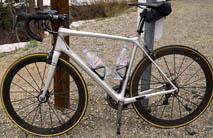Water Bottles for Cycling
Standard water bottles for cycling are awful:
- Two standard bike bottles add up to 100g extra weight over my “Evian” alternative.
- Standard bike bottles impart a nasty taste to the water, especially when they get hot.
- Capacity of standard bottles is insufficient for longer rides.
- Standard cycling bottles need to be cleaned and washed, a chore if the bottle has held certain sports drinks; and the possibly hormone-disrupting plastics also stain from the contents, showing that they are not a fully hygienic solution.
I use off-the-shelf Evian 1 liter bottles for all my rides:
- I get a clean-tasting drink even when the bottle gets very hot.
- A wider mouth on the bottle allows downing 1/3 liter fluid in a short time.
- Substantially more fluid capacity than even oversized cycling bottles.
- Weight savings of up to 50g per bottle as compared to standard bottles. You won’t find a cheaper way to lighten your bike.
Most other water brands offer poor quality bottles with a narrower mouth and/or a lighter weight plastic that crushes too easily, leading to poor fit and/or leaks. The Evian bottle is a studied choice, not a generic or random one.
If you don’t like the screw top (I’ve used it very successfully for years), then look for screw-on caps of the same type as standard cycling bottles.
There are two downsides to the Evian bottles:
- It’s hard to get a powdered mix into the bottle (quickly) without making a mess. OTOH, most double centuries let you send ahead stuff to 2 or 3 rest stops, so you can just have 'em pre-mixed and toss the used ones.
- An empty bottle makes some noise when the road is a little rough.
- The labels can peel off at inconvienent times; remove them in advance.
Why so much water?
My 2004 Everest Challenge was a hot one. I consumed about 2 gallons of fluid that day. If the rest stops are a bit too far apart given the conditions, one could dehydrate during the race3 beyond the point of recovery.
At the end of the first day, I had consumed 2 gallons of fluid. There were 1/2" high salt crystals growing out of my helmet straps (wish I had taken a photo!), and the local wildlife was running after me to lick my legs.
Fluid requirements increase with body size, so larger riders are well served by carefully considering their hydration needs, and using appropriate capacity bottles.




